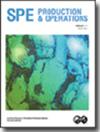Emulsification Characteristics and Electrolyte-Optimized Demulsification of Produced Liquid from Polymer Flooding on Alaska North Slope
IF 1.3
4区 工程技术
Q2 ENGINEERING, PETROLEUM
引用次数: 3
Abstract
The first-ever polymer flooding pilot test is currently implemented in heavy oil reservoirs on Alaska North Slope (ANS). One of the major concerns of field engineers is the impact of polymer on oil/water separation after polymer breakthrough. This paper aims to predict the influence of polymer on emulsification characteristics of produced liquid and seek a cost-effective method to treat the produced liquid from polymer flooding. In this study, emulsions, at moderate and vigorous shearing conditions, were prepared by mechanically mixing 25 vol% of the ANS heavy oil with 75 vol% of the polymer solution. Bottle test method, microscope, and pendant drop technique were utilized to investigate the effect of polymer on emulsification characteristics in terms of separation behavior, drop size distribution (DSD), and interfacial properties [i.e., interfacial tension (IFT) and interfacial dilational rheology], respectively. As for chemical demulsification, the performance and interfacial behavior of four commercial demulsifiers and an inorganic salt, that is, potassium chloride (KCl), was measured using simulated produced liquid. The bottle test results demonstrated that polymer could enhance the emulsion stability, resulting in a slower separation rate, poorer water quality, and greater thickness of the intermediate layer. The pendant drop measurements showed that the IFT and interfacial dilational rheology were independent of polymer concentration. Thus, the stabilization effect of the polymer was mainly attributed to the increased viscosity of the continuous phase and the decreased drop size of the dispersed oil phase. As for the chemical demulsification tests, compound demulsifier E12 + E18 exhibited the best demulsification performance as well as the lowest IFT and interfacial elastic modulus. Nevertheless, a multifold dosage of E12 + E18 was required to demulsify the emulsion under vigorous mixing, leading to a potential increase in the chemical cost. A less expensive electrolyte, KCl, was able to work synergistically with demulsifier E12 + E18 to promote oil/water separation and reduce the demulsifier usage. In this proposed demulsifier formula, the mechanism for the effectiveness of the commercial demulsifier was its destructive effect on the interfacial film, while the effectiveness of KCl was mainly dependent on its viscosity reduction effect on the continuous phase. This study illustrates the intermediate layer elimination, and the water quality is the major challenge for produced liquid from polymer flooding and provides both practical and theoretical guidance in advance for the corresponding demulsification strategy of the produced liquid from the ongoing first-ever polymer flooding pilot on ANS.阿拉斯加北坡聚合物驱采出液的乳化特性及电解质优化破乳
首次聚合物驱先导试验目前正在阿拉斯加北坡(ANS)的稠油油藏中进行。油田工程师主要关注的问题之一是聚合物突破后聚合物对油水分离的影响。本文旨在预测聚合物对采出液乳化特性的影响,寻求一种经济高效的聚合物驱采出液处理方法。在本研究中,通过将25体积%的ANS重油与75体积%的聚合物溶液机械混合,在中等和剧烈剪切条件下制备乳液。分别从分离行为、液滴尺寸分布(DSD)和界面性质(即界面张力(IFT)和界面膨胀流变学)方面,利用瓶试验法、显微镜和悬滴技术研究了聚合物对乳化特性的影响。在化学破乳方面,用模拟采出液测定了四种市售破乳剂与一种无机盐氯化钾(KCl)的性能和界面行为。瓶子试验结果表明,聚合物可以提高乳液的稳定性,导致分离速度较慢,水质较差,中间层厚度较大。悬滴测量表明,界面张力和界面膨胀流变学与聚合物浓度无关。因此,聚合物的稳定作用主要归因于连续相的粘度增加和分散油相的液滴尺寸减小。在化学破乳试验中,复合破乳剂E12+E18的破乳性能最好,IFT和界面弹性模量最低。然而,在剧烈混合下需要E12+E18的倍数剂量来破乳乳液,导致化学成本的潜在增加。较便宜的电解质KCl能够与破乳剂E12+E18协同作用,促进油/水分离并减少破乳剂的使用。在该破乳剂配方中,商业破乳剂的有效性机理是其对界面膜的破坏作用,而KCl的有效性主要取决于其对连续相的降粘作用。这项研究说明了中间层的消除,水质是聚合物驱采出液面临的主要挑战,并为正在进行的ANS首次聚合物驱试验采出液的相应破乳策略提供了实践和理论指导。
本文章由计算机程序翻译,如有差异,请以英文原文为准。
求助全文
约1分钟内获得全文
求助全文
来源期刊

Spe Production & Operations
工程技术-工程:石油
CiteScore
3.70
自引率
8.30%
发文量
54
审稿时长
3 months
期刊介绍:
SPE Production & Operations includes papers on production operations, artificial lift, downhole equipment, formation damage control, multiphase flow, workovers, stimulation, facility design and operations, water treatment, project management, construction methods and equipment, and related PFC systems and emerging technologies.
 求助内容:
求助内容: 应助结果提醒方式:
应助结果提醒方式:


